The Crusade for Pre/Postnatal Fitness, Interview with Haley Shevener, RKC-II
By Adrienne Harvey, SrPCC, RKC-II, CK-FMS
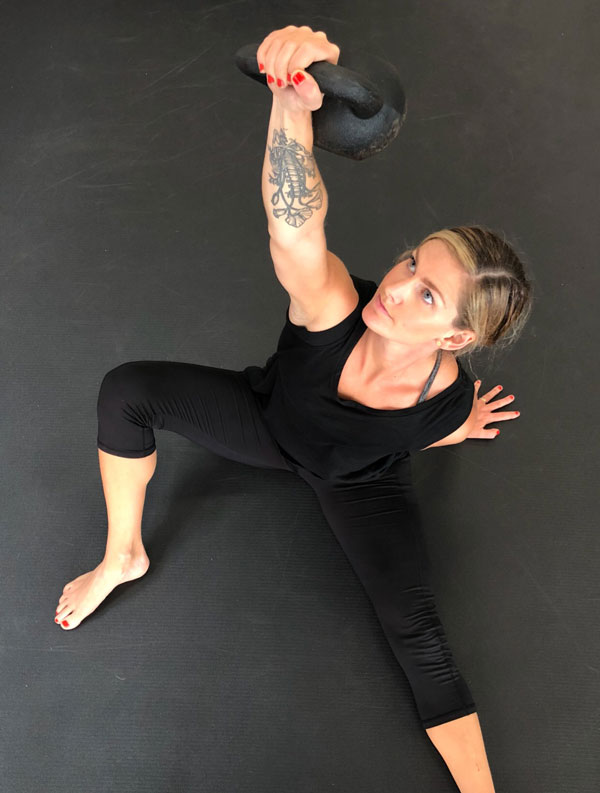
Dragon Door: Dan John mentioned that you specialize in pre- and postnatal fitness, how you become interested in this subject?
Haley Shevener: My interest peaked when I got pregnant with my son. I was looking for information and had spent hours on PubMed sifting through research. And, I didn’t find a lot of great information—even though there was a lot for women who were doing yoga, Pilates, swimming and walking. But, I didn’t find much information about weightlifting or for women who had been performing at a higher athletic level before becoming pregnant. There was a huge lack of information for people like me.
The advice I found was to either keep doing everything you've always been doing as long as it feels good, or to stop everything and just sit and wait. Intuitively I knew that neither of those approaches were ideal, but it was really hard to decipher what an approach in the middle might be. Since I already had pre- and post-natal fitness certifications, it was frustrating to realize I still didn’t have conclusive enough information! It became my crusade.
After having my son, I ended up with pelvic floor dysfunction, namely pelvic organ prolapse. And, my condition was worsened by the way I was training. In part, this was because I didn’t initially present with symptoms that seemed out of the ordinary. I also realized I was not alone and that many women deal with pelvic floor dysfunction, diastasis recti, and pelvic organ prolapse.
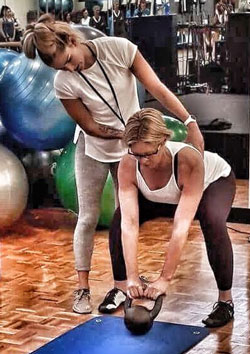
All of these conditions are very common for women who have had children and who may initially present with very mild symptoms that most will write off as "normal". They’re even common for women who have had easy pregnancies and deliveries. Even after getting the "OK" from their doctors to return to the gym, these women often end up getting injured. When I realized how often this was happening, I switched gears and started working exclusively with women in this life chapter. I’m now the Head of Methodology and a Pre/Postnatal Exercise Specialist at The Lotus Method, a Pre/Postnatal specific studio.
There’s a real lack of information. Even the pre/postnatal certified trainers who contact me, or trainers who work with moms only know generalities. They don’t know how to train women with prolapse, even though studies have shown that roughly half the women who’ve had a baby may suffer from some degree of prolapse in their lifetime. No one is talking about prolapse. Most of the information trainers have simply doesn’t reflect the growing needs of women trying to get back to athletic endeavors—or who need to raise their kids and pick up heavy everyday items.
Many of the women who come to work with me have no idea what to do, and their doctors haven’t given them any information. They may see posts on social media that don’t emphasize the recovery and restoration of function that needs to happen after a woman has a baby and instead celebrate how quickly someone was able to get back into the gym. It’s a vulnerable time for these women—especially athletes who often have a significant portion of their identity wrapped up in their physical abilities. They’re really frustrated—and that’s why I’ve chosen to focus on this demographic.
Dragon Door: Over the past several years conducting
interviews for Dragon Door, I have spoken to a few women who have done some postnatal training, and much like yourself, they’ve had to be their own test subjects. There also seems to be a huge range of experiences and successes.
Haley Shevener: I think women are underserved in fitness, and moms seem to be completely under the radar. Pelvic floor dysfunction doesn't just affect moms, either. Research suggests a surprising number of young female athletes who have never had children are dealing with issues like incontinence. At one point, the CrossFit world even put out the message that you're not working hard enough if you're not leaking during double unders. But, this is actually a symptom of a larger issue every fitness professional should be qualified to address. It shouldn't just be a weird niche women's health issue, it should be common knowledge.
Anyone working with women who have given birth is already training people with prolapse, pelvic floor dysfunction, or diastasis recti. You must know the implications of those conditions, especially when working with a dynamic training method like kettlebells.
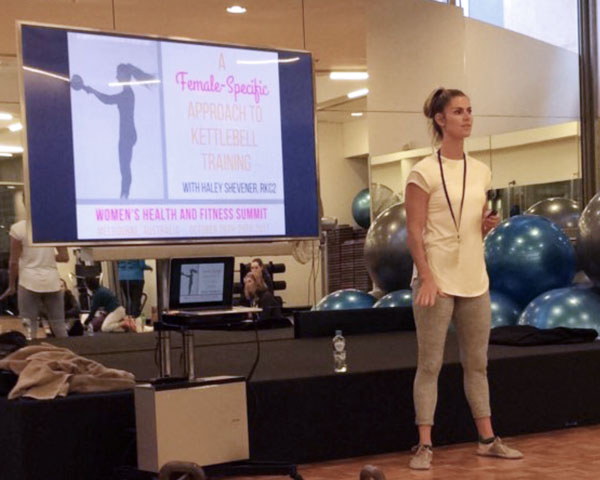
Dragon Door: How long have you been involved with pre-and postnatal training?
Haley Shevener: My son is now two and a half years old, and I began about nine months before that—so, a little over three years now.
Dragon Door: How were you training before?
Haley Shevener: I started training in 2005 when everybody was using machines. Then around 2008, I saw
Kettlebells from the Ground Up by Gray Cook and Brett Jones and I was just really blown away. I'd been a fan of Gray Cook's work for a while but when I saw this, I knew I needed to try it. I started training with
kettlebells on my own, but didn’t really get serious about it until about a year before I ended up getting pregnant. I got really interested in training for Strong First, but as soon as I signed up for it, I got pregnant, so that wasn’t going to happen. Once I had my son, I started training really intensely, then seven months later was diagnosed with pelvic organ prolapse.
If you look up pelvic organ prolapse online, there’s a lot of fear mongering and unrealistic information that essentially says this diagnosis means your athletic career is over. It was a really dark time when I first got the diagnosis because my identity is associated with my strength. I just really wanted to be able to swing a kettlebell, and still had it in my mind that I wanted to get certified—somehow.
In February, I was able to pass the
RKC which was a huge milestone in my recovery and overall career. It was great to be able to do it, even with a diagnosis that many felt should have completely kept me from
kettlebell training. I've been able to reduce my symptoms, and in the process have learned so much more about myself, and how I approach training women.
Dragon Door: And most recently, you went on to earn your RKC-II certification! What were some of the highlights of that workshop for you?
Haley Shevener: It was just great being in that inspiring community and environment. I am always reminded of why I do the work that I do when I go to these events. Obviously,
Dan John is a legend. The RKC-II felt like the summation of a lot that I’ve been working on. When I did RKC-I, I was really nervous the whole time and really cognizant of managing my symptoms. I was still managing my symptoms at the RKC-II, but I was also able to chill out a little bit and take it all in.
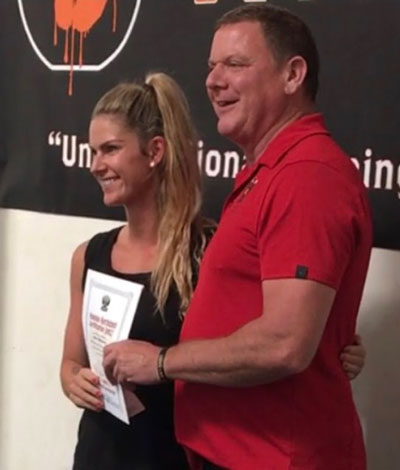
One thing that was most impactful, but had nothing to do with kettlebells, was learning how to map out my training. That’s been huge for me since I am managing a chronic condition. Approaching training from a longevity standpoint is better for me, and for everyone I train. It was also great to revisit the basics. I was really nervous about the pistol squat, but the drills we learned and practiced at the event really helped me.
The
RKC-II was quality instruction with awesome encouragement from everybody who was participating. That is so unique for a workshop, because the fitness industry often feels so competitive. It’s nice to be at an event that when somebody finally gets the press, everybody's cheering.
Dragon Door: You mentioned the swing earlier, is that your favorite kettlebell exercise?
Haley Shevener: Yes, but the close runner up would be the windmill. In the kettlebell swing there's that one moment when it floats and everything just feels weightless. It sounds cheesy, but it’s a good metaphor for how I feel when I’m working with kettlebells. The
windmill is on the opposite side of the spectrum and has a really nice groove to it. It’s graceful and just feels really good.
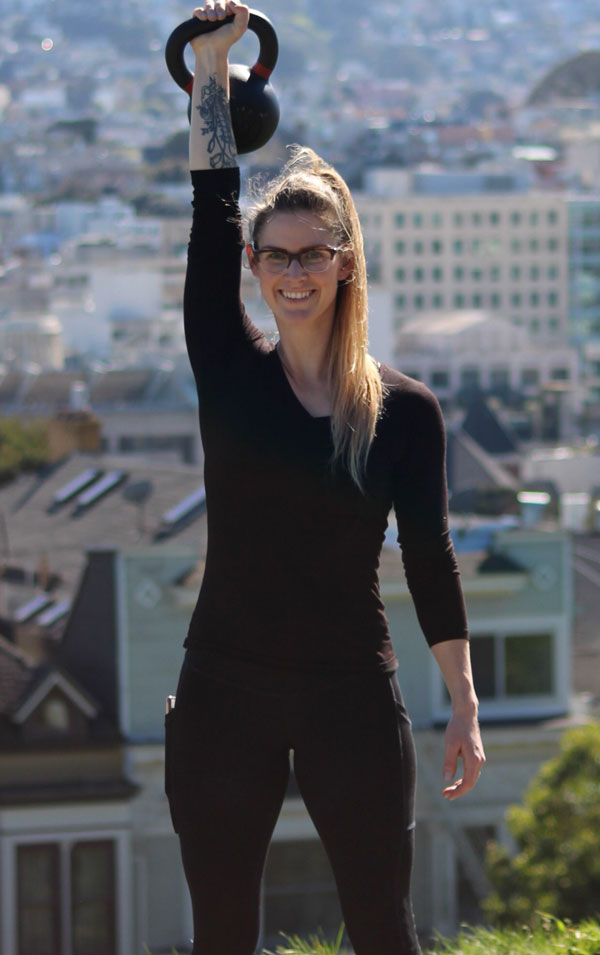
Dragon Door: What's your next goal? What are you working towards personally or professionally?
Haley Shevener: On Wednesday I'm flying to Australia and presenting a female specific approach to kettlebell training. I will be talking about the experience of going though this process—and the modifications and strategy adjustments I've had to make. I will also be sharing suggestions for women interested in
Hardstyle kettlebell training but who have pelvic floor conditions, are pregnant, or are going through menopause. We’re going to discuss the whole gamut of women's health concerns. My presentation is 90 minutes long, and is half practical and half discussion-based. I’m super stoked about it.
Dragon Door: Can you recommend a good resource for trainers who are interested in starting to learn about pre-and postnatal training?
Haley Shevener: There's currently nothing out there that speaks specifically to training pre/postnatal women in the style of Hardstyle kettlebell, but that’s why I am developing a resource that addresses those concerns. Once a woman has had a baby, there are training considerations that need to be addressed, even when her kids are older. A lot of these women's health concerns revolve around the management of intra-abdominal pressure. If we have increases in intra-abdominal pressure that we can’t contain—due in part to an abdominal wall or pelvic floor that has been compromised or is not functioning well—conditions like pelvic organ prolapse, incontinence, hernias, and diastasis recti become more likely.
I am working on a straightforward resource for beginners as well as experienced trainers who might already be certified. It will break down the movements, timing, alignment, and guidelines for other strategy modifications. It is worth mentioning that no resource can take the place of a qualified pelvic floor physical therapist, a practitioner that every woman who has had a baby should visit.
My colleagues and friends, Brianna Battles and Jessie Mundell, both have excellent resources for coaches and trainers looking to work with female athletes. You can find them at
Briannabattles.com and
JessieMundell.com.
I whole-heartedly recommend the work of both Julie Wiebe (
juliewiebept.com) and Antony Lo (
physiodetective.com) for more guidance on the considerations to make for pre/postnatal athletes—and women in general. They are both brilliant physical therapists and their work is a foundation coaches and trainers can use to deepen their understanding for working with this population.
Back